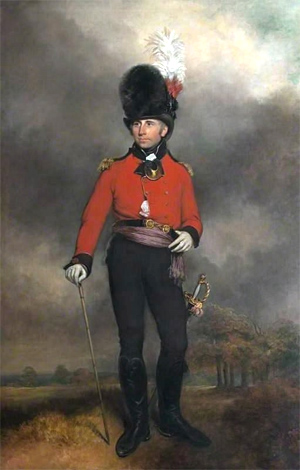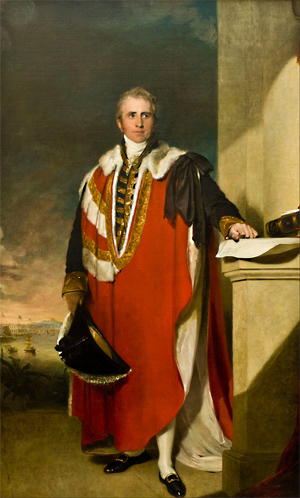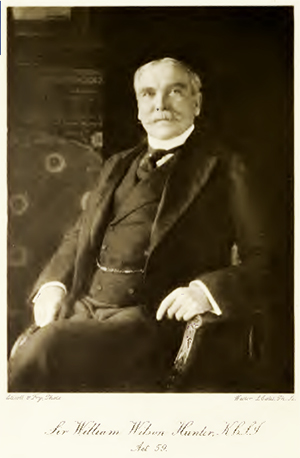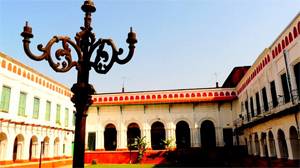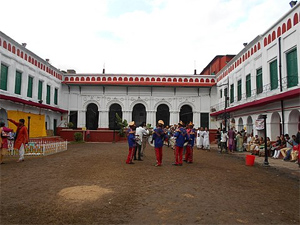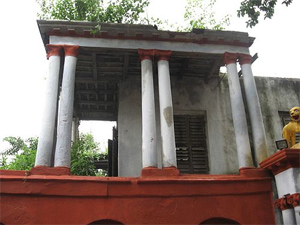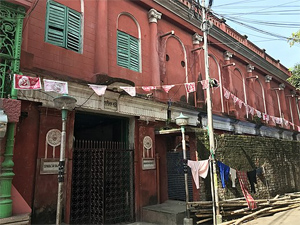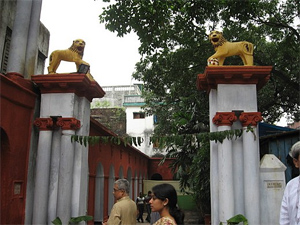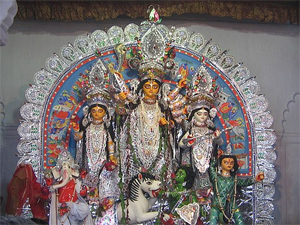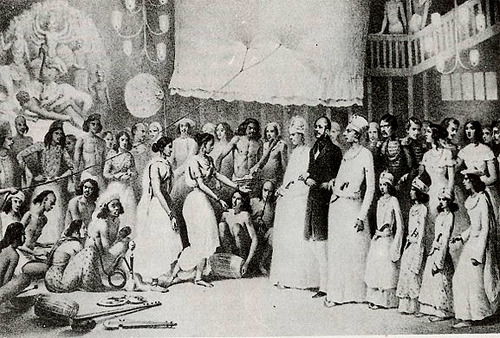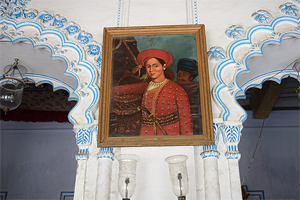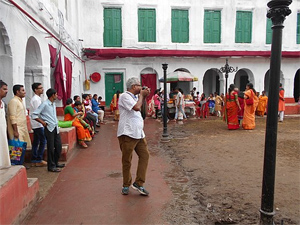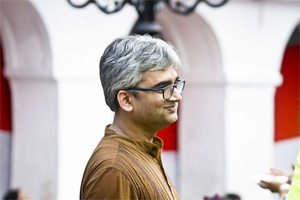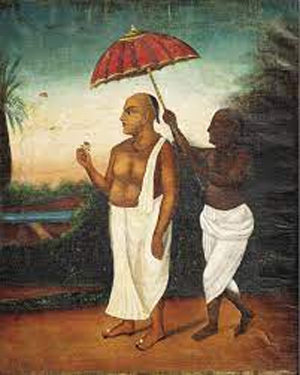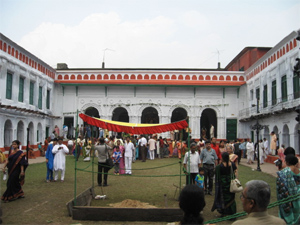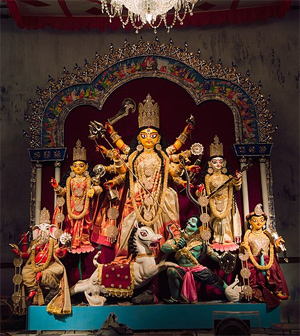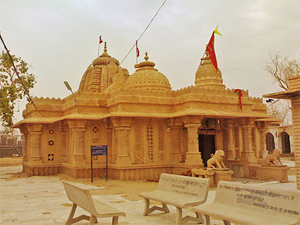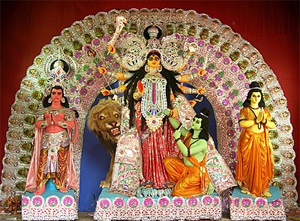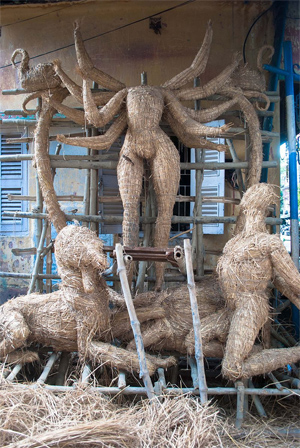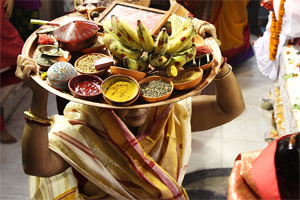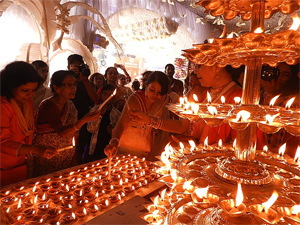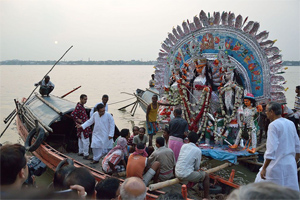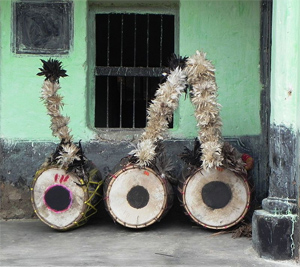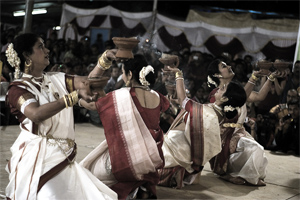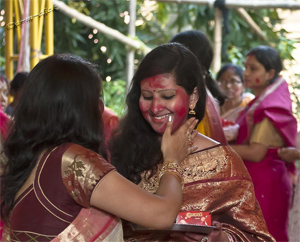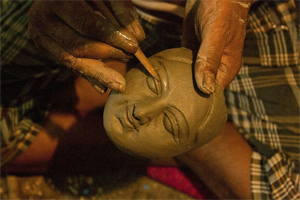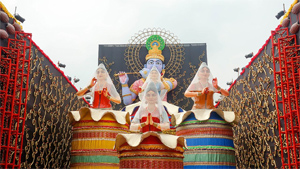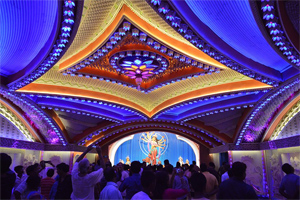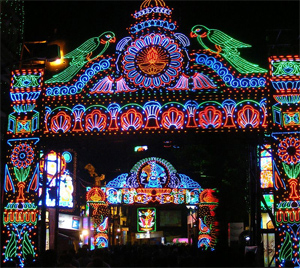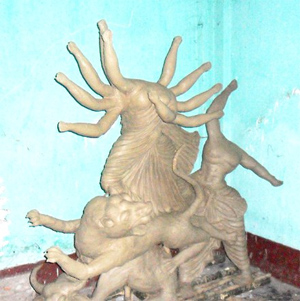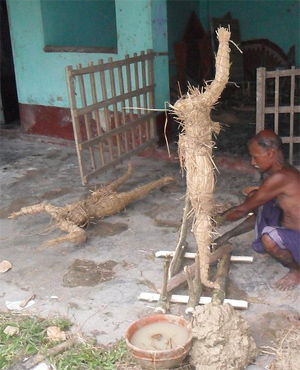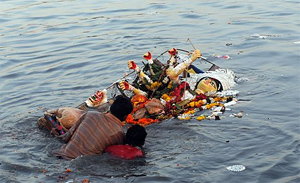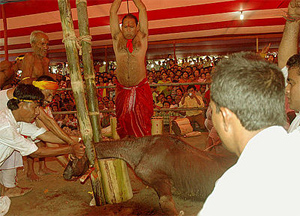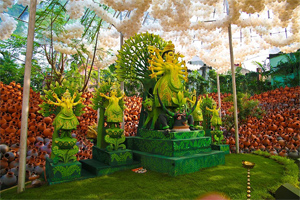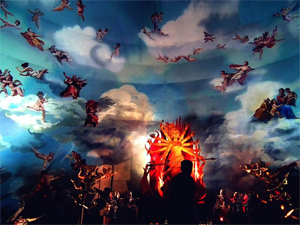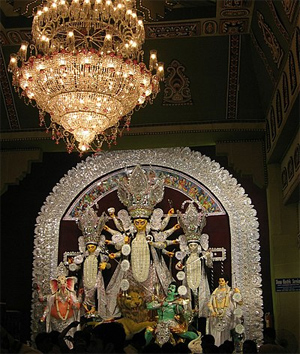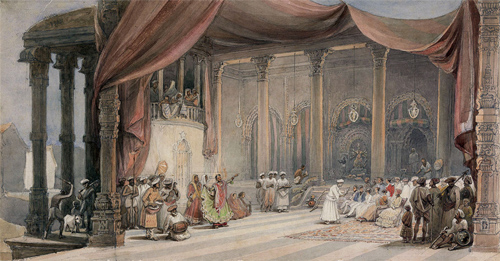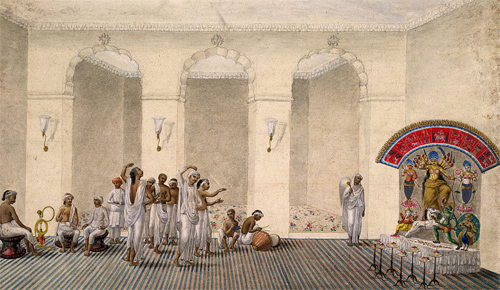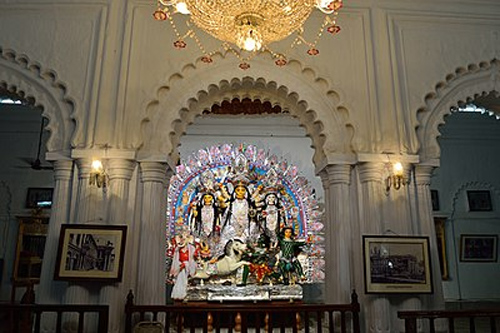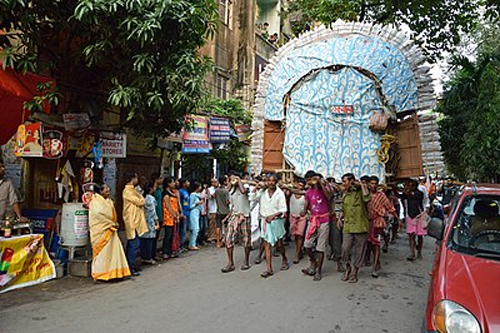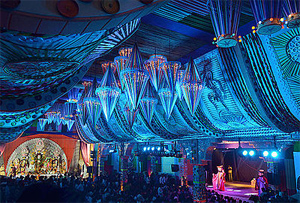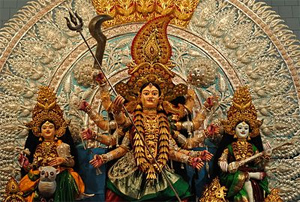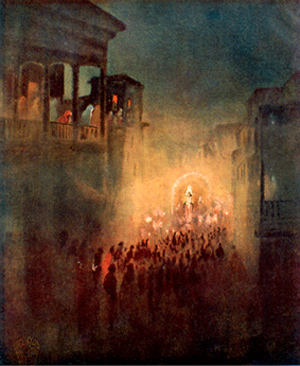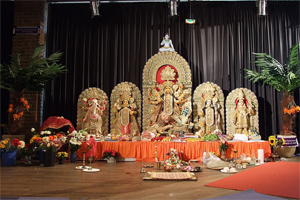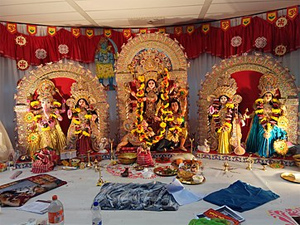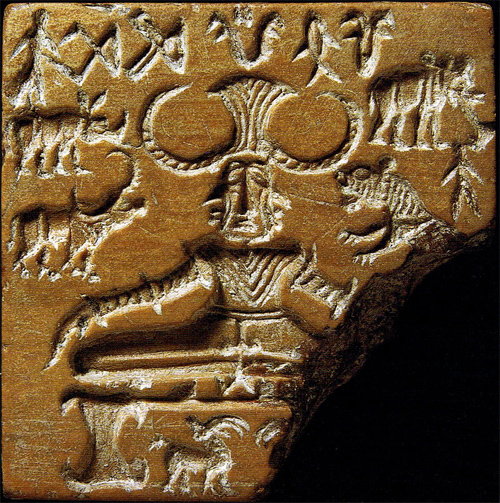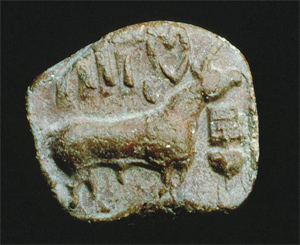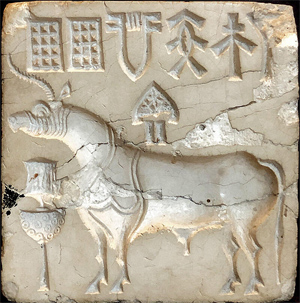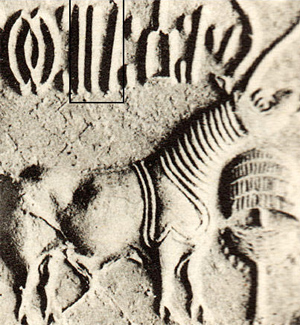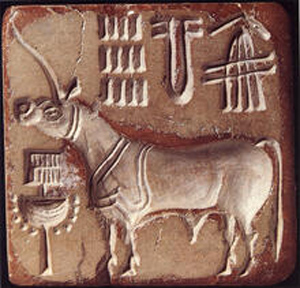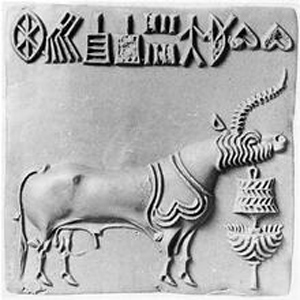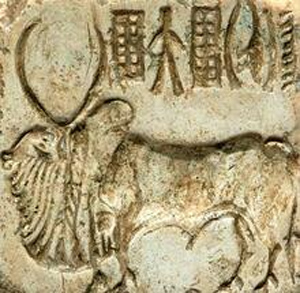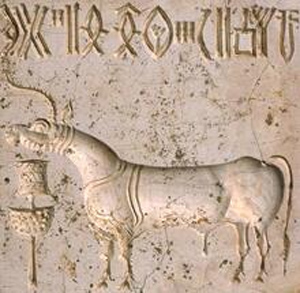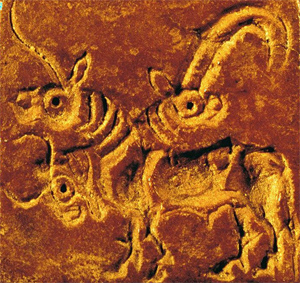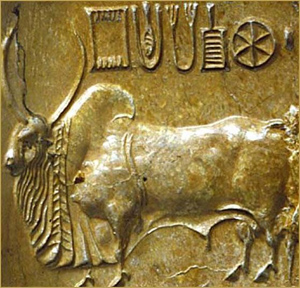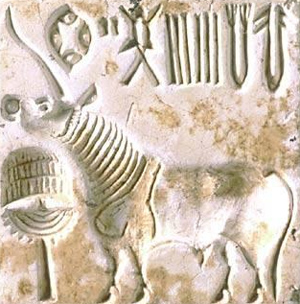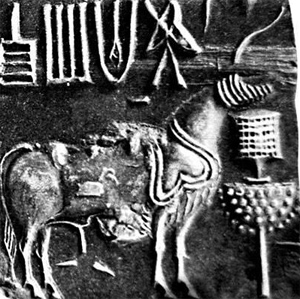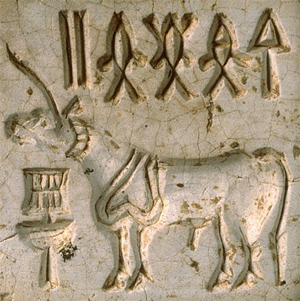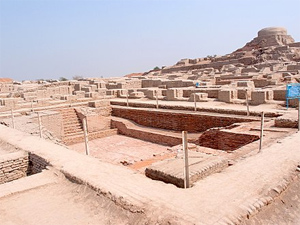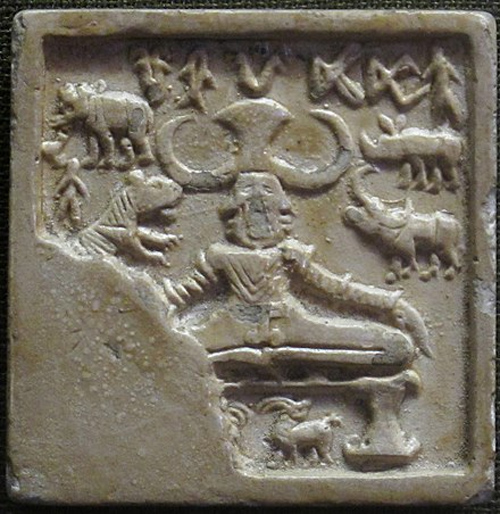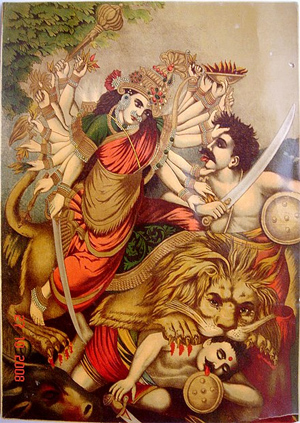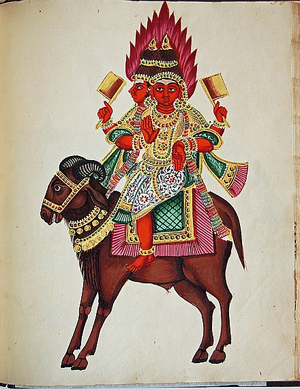Durgaby Wikipedia
Accessed: 4/5/21
-- Nabakrishna Deb, by Wikipedia
-- Gopi Mohun Deb, by Wikipedia
-- Radhakanta Deb, by Wikipedia
-- Shobhabazar Rajbari, by Wikipedia
-- Durga Puja, by Wikipedia
-- Durga, by Wikipedia
-- The Myth of Matriarchal Prehistory: Why an Invented Past Won't Give Women a Future, by Cynthia Eller
-- Interesting Historical Events, Relative to the Provinces of Bengal, and the Empire of Indostan. With a Seasonable Hint and Persuasive to the Honourable The Court of Directors of the East India Company. As Also The Mythology and Cosmogony, Fasts and Festivals of the Gentoo's, Followers of the Shastah. And a Dissertation on the Metempsychosis, commonly, though erroneously, called the Pythagorean Doctrine, Parts I, II, and III, by J.Z. Holwell, Esq.
-- India Tracts, by Mr. J. Z. Holwell, and Friends.
-- The Black Hole: The Question of Holwell's Veracity, by J. H. Little
-- Full Proceedings of the Black Hole Debate, Bengal, Past & Present, Journal of the Calcutta Historical Society
-- History of Hindostan; From the Earliest Account of Time, To the Death of Akbar; Translated From the Persian of Mahummud Casim Ferishta of Delhi: Together With a Dissertation Concerning the Religion and Philosophy of the Brahmins; With an Appendix, Containing the History of the Mogul Empire, From Its Decline in the Reign of Mahummud Shaw, to the Present Times, by Alexander Dow.
-- Reflections on the Present State of our East-India Affairs; With Many Interesting Anecdotes Never Before Made Public, by Gentleman Long Resident in India
-- The History of British India, vol. 1 of 6, by James Mill
-- The History of British India, vol. II, by James Mill
-- The History of British India, vol. III, by James Mill
-- The Golden Bough: A study of magic and religion, by Sir James George Frazer
-- The Buddhism of Tibet, or Lamaism With Its Mystic Cults, Symbolism and Mythology, and in its Relation to Indian Buddhism, by Laurence Austine Waddell, M.B., F.L.S., F.R.G.S.
As we have seen, the iambics of Halhed's ode construct a contrast between the elevated 'monotheism' of pristine Hinduism, with its 'primeval Reshees' worshipping, 'One great eternal, undivided Lord' (l.8) and what he judges to be the debased and debauched ritual of the cults he had witnessed at Benares:
What pious Hindu hails not Doorgha's vault?
Nich'd in an angle of the seven-foot space
Stands a gaunt semblance of th' ill favour'd hag:
Her grizzled carcase and unseemly base
Veil'd in a squalid yard of scanty rag.
A silver'd convex marks each garish eye,
Her hideous visage shines imbrued with ink:
And as the bramin waves his lamp on high
The satisfied adorer sees her wink. (l. 40)
Halhed's hostility towards the worship of Kali/Durga was doubtless a reaction to enormous explosion of interest in this sakta goddess and her worship in late eighteenth-century Bengal. Rachel McDermott has examined how the celebration of Durga Puja (a nine-day autumn festival to celebrate the fertilizing effects of the goddess's fiery prowess) reflects the shifting power configurations between the Muslim nawabs, the Hindu zamindars, and the East India Company.41 [Rachel McDermott, 'Unanswered Questions on the Relationship between Politics, Economics, and Religion: The Case of Durga Puja in Late Eighteenth-Century Bengal', paper read at the University of Chicago 'Bengal Studies Conference', 28-30 April 1995, published at
http://www.libuchicago.edu/LibInfo/Sour ... hel.l.html.] She points to debate amongst historians concerning the reasons for this increased attention to Durga and her festival; some scholars argue that it reflects increase of Hindu wealth under the nawabs' lenient rule prior to the Battle of Plassey (1757), whereas others see it as the product of a new climate of stability and opportunity under the British after the transfer of power in 1765 to the East India Company, which itself patronized Durga Puja.42 ['The most amazing act of worship was performed by the East India Company itself: in 1765 it offered a thanksgiving Puja, no doubt as a politic act to appease its Hindu subjects, on obtaining the Diwani of Bengal (including Bihar and Orissa). The sum spent is cited variously as having been between Rs. 5,000 and Rs. 30,000' (Calcutta, the Living City, Vol. 1: The Past, ed. by Sukanta Chaudhuri (Calcutta: Oxford University Press, 1990), p. 25).]
Claims concerning festival patronage are overlaid with sectarian polemic or political rhetoric asserting the relative value of Muslim and secular Company rule, but what clearly emerges is European attendance and even involvement in the festivals. John Scott, relying upon largely sympathetic sources in Holwell and Dow, represents the Puja in his 'Serim; or, The Artificial Famine' (1782) as a virtually vegetarian affair; the 'Grief and Terror' are the product of famine created by harsh Company policies:
Bring Joy, bring Sport, the song, the dance prepare!
'Tis Drugah's Feast, and all our friends must share!
The year revolves -- nor fruits nor flowers are seen;
Nor festive board in bowers of holy green;
Nor Joy, nor Sport, nor dance, nor tuneful strain:
'Tis Drugah's feast -- but Grief and Terror reign.
Yet there, ingrate! oft welcome guests ye came,
And talk'd of Honour's laws and Friendship's flame.43 [Scott's note reads: 'Drugah; a Hindoo Goddess. "Drugah Poojah is the grand general feast of the Gentoos, usually visited by all Europeans (by invitation), who are treated by the proprietors of the feast with the fruits and flowers in season, and are entertained every evening with bands of singers and dancers." Vide Holwell's Indostan, vol. ii' (Poetical Works, p. 144).]
William Ward, however, writing from Serampore mission with a very different religious and political agenda, precisely noted that the blood of 65,535 goats was shed by Raja Isvarcandra to propitiate Durga during the course of one Puja.44 [William Ward, Account of the Writings, Religion and Manners of the Hindoos, 4 vols, (Serampore: Mission Press, 1811), 111, 116.] Josiah Conder, disgusted with how 'at Doorga feasts, the Christian fair / Did graceful homage to the mis-shaped gods, / And pledged the cup of demons', waxed positively nostalgic for the 'righteous sword of Mahomed, which gave / The shaven crowns of those infernal priests / To their own goddess, a meet sacrifice, -- / Fresh beads for Kali's necklace'.45 [The Star in the East, ll. 113-15; 126-29. Emma Roberts mentions the scandal caused by eminent English performers playing Handel at a Durga Puja, Scenes and Characteristics of Hindostan, 2 vols (London: Allen, 1837), II, 360.]
-- Cultural Possession, Imperial Control, and Comparative Religion: The Calcutta Perspectives of Sir William Jones and Nathaniel Brassey Halhed, by Michael J. Franklin
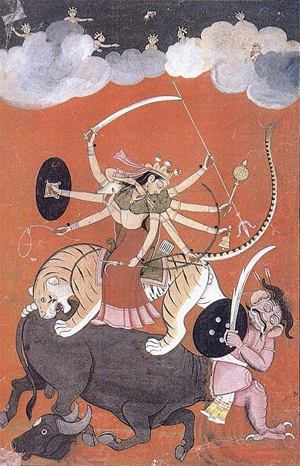
Durga
Mother Goddess; Goddess of Preservation, Strength and Protection
Durga slays the Buffalo demon, Mahishasura
Affiliation Devi, Shakti, Adi-Parashakti, Chandi, Kali
Weapon Chakra (discus), Shankha (conch shell), Trishula (Trident), Gada (mace), Bow and Arrow, Khanda (sword) and Shield, Ghanta (bell)
Mount Tiger or Lion[1][2]
Festivals Durga Puja, Durga Ashtami, Navratri, Vijayadashami
Personal information
Siblings Vishnu[3]
Consort Shiva[4][note 1]
Manipuri equivalent Panthoibi[5]
Durga (Sanskrit: दुर्गा, IAST: Durgā) is one of the principal Hindu deities, described to the
goddess of war, strength and protection.[6][7][8] Her legend centres around combating evils and demonic forces that threaten peace, prosperity, and Dharma the power of good over evil.[7][9] Durga is also a fierce form of the protective mother goddess, who unleashes her divine wrath against the wicked for the liberation of the oppressed, and entails destruction to empower creation.[10]
The earliest depiction of Durga is found in the seals of Indus Valley Civilization. The Harappan Goddess of War?by Harappa.com
January 15th, 2017
[Sitewide Search for "Durga" at Harappa.com yielded Zero "0" results]https://www.harappa.com/category/blog-subject/seals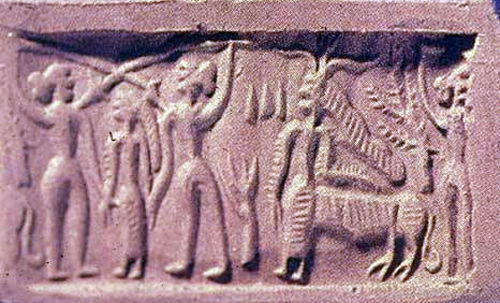
"The Harappans had a goddess of war connected with the tiger, another large feline that was once native to the Indus Valley. On a cylinder seal from Kalibangan (Image 1, 2), a goddess in long skirt and plaited hair holds the hands of two warriors in the process of spearing each other. Next to this scene, the same deity is shown with an elaborate horn crown and the back part of a tiger as a continuation of her body. The hair of the two warriors is arranged into the double bun' or chignon at the back of the head, characteristic of Late Early Dynastic Mesopotamian kings on the warpath. As in the later South Asian tradition, this tiger-riding goddess of war apparently received water buffaloes in sacrifice. There are several Harappan images of a man who spears a water buffalo while placing one of his feet on the head of the beast. This pose came to signify 'victory' in Mesopotamian glyptic art during the reign of Sargon the Great (2334-2279 BCE)."
Asko Parpola, The Harappan Unicorn in Eurasian and South Asian perspectives, p. 158.
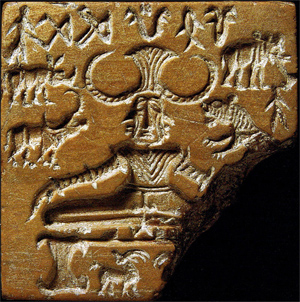 The Pashupati Seal is a steatite seal that was discovered at the Mohenjo-daro archaeological site of the Indus Valley Civilization. The seal depicts a seated figure that is possibly tricephalic (having three heads).
The Pashupati Seal is a steatite seal that was discovered at the Mohenjo-daro archaeological site of the Indus Valley Civilization. The seal depicts a seated figure that is possibly tricephalic (having three heads). It was once thought to be ithyphallic, an interpretation that has been questioned by many critics and even supporters.
The man has a horned headdress and is surrounded by animals. He may represent a horned deity. The seal is kept in the National Museum of India in New Delhi.
It has one of the more complicated designs in the
thousands of seals found from the Indus Valley Civilization, and is unusual in having a human figure as the main and largest element; in most seals this is an animal. It has been claimed to be one of the earliest depictions of the Hindu god Shiva, or a "proto-Shiva" deity. The name given to the seal, "pashupati", meaning "lord of animals", is one of Shiva's epithets. It has also been associated with the Vedic god Rudra, generally regarded as an early form of Shiva. Rudra is associated with asceticism, yoga, and linga; regarded as a lord of animals; and Shiva may be depicted with three heads. The figure has often been connected with the widespread motif of the Master of Animals found in ancient Near Eastern and Mediterranean art, and the many other traditions of horned deities.The seal was uncovered in 1928-29, in Block 1, Southern Portion of the DK-G Area of Mohenjo-daro, at a depth of 3.9 meters below the surface. Ernest J. H. Mackay, who directed the excavations at Mohenjo-daro, and dated the seal to the Intermediate I Period (now considered to fall around 2350-2000 BCE) in his 1937-38 report in which the seal is numbered 420, giving it its alternate name.
The seal is carved in steatite and measures 3.56 cm by 3.53 cm, with a thickness of 0.76 cm. It has a human figure at the centre seated on a platform and facing forward.
The legs of the figure are bent at the knees with the heels touching and the toes pointing downwards. The arms extend outwards and rest lightly on the knees, with the thumbs facing away from the body. Eight small and three large bangles cover the arms. The chest is covered with what appear to be necklaces, and a double band wraps around the waist. The figure wears a tall and elaborate headdress with central fan-shaped structure flanked by two large striated horns. The human figure is surrounded by four wild animals: an elephant and a tiger to its one side, and a water buffalo and a rhinoceros on the other. Under the dais are two deer or ibexes looking backwards, so that their horns almost meet the center. At the top of the seal are seven pictographs, with the last apparently displaced downwards for lack of horizontal space.Interpretations
Marshall's identification with proto-ShivaAn early description and analysis of the seal's iconography was provided by archaeologist John Marshall who had served as the Director-General of the Archaeological Survey of India and led the excavations of the Indus Valley sites. In addition to the general features of the seal described above, he also saw the central figure as a male deity; as three-faced, with a possible fourth face towards the back; and, as ithyphallic, while conceding that what appeared to be the exposed phallus could instead be a tassel hanging from the waistband. Most significantly
he identified the seal as an early prototype of the Hindu god Shiva (or, his Vedic predecessor, Rudra), who also was known by the title Pashupati ('lord or father of all the animals') in historic times. In a 1928–29 publication, Marshall summarized his reasons for the identification as follows:
My reasons for the identification are four. In the first place the figure has three faces and that Siva was portrayed with three as well as with more usual five faces, there are abundant examples to prove. Secondly, the head is crowned with the horns of a bull and the trisula are characteristic emblems of Siva. Thirdly, the figure is in a typical yoga attitude, and Siva [sic] was and still is, regarded as a mahayogi—the prince of Yogis. Fourthly, he is surrounded by animals, and Siva is par excellence the "Lord of Animals" (Pasupati)—of the wild animals of the jungle, according to the Vedic meaning of the word pashu, no less than that of domesticated cattle.
Later, in 1931, he expanded his reasons to include the fact that Shiva is associated with the phallus in the form of linga, and that in medieval art he is shown with deer or ibexes, as are seen below the throne on the seal.
Marshall's analysis of the Indus Valley religion, and the Pashupati seal in particular, was very influential and widely accepted for at least the next two generations. For instance, Herbert Sullivan, wrote in 1964 that Marshall's analysis "has been accepted almost universally and has greatly influenced scholarly understanding of the historical development of Hinduism". Writing in 1976, Doris Srinivasan introduced an article otherwise critical of Marshall's interpretation by observing that "no matter what position is taken regarding the seal's iconography, it is always prefaced by Marshall's interpretation. On balance the proto-Śiva character of the seal has been accepted." Thomas McEvilley noted, in line with Marshall, that the central figure was in the yoga pose Mulabandhasana, quoting the Kalpa Sutra's description "a squatting position with joined heels" used with meditation and fasting to attain infinite knowledge (kevala). And Alf Hiltebeitel noted in 2011 that, following Marshall's analysis, "nearly all efforts at interpreting the [Indus Valley] religion have centered discussion around [the Pashupati seal] figure". A lot of discussion has taken place about this seal. While Marshall's work has earned some support, many critics and even supporters have raised several objections.
Doris Srinivasan's reinterpretationDoris Srinivasan, a professor of Indian studies, raised objections to Marshall's identification, and provided a new interpretation for the figure, where she postulated the lateral projections were cow-like ears rather than faces. In 1975-76, she published a journal article titled 'The So-Called Proto-śiva Seal from Mohenjo-Daro: An Iconological Assessment' in the academic journal Archives of Asian Art. In 1997, she reiterated her views in a book titled Many Heads, Arms, and Eyes: Origin, Meaning, and Form of Multiplicity in Indian Art.
According to her, the two extra faces could be reinterpreted as possible ears, and the central face has predominant bovine features. She has drawn similarities between the central figure of seal 420, and other artefacts from the Indus Valley such as the horned mask from Mohenjo-Daro, the terracotta bull from Kalibangan, and the depiction of a horned deity on a water pitcher from the archaeological site of Kot Diji. She has also noted that the yogic posture of the figure is repeated on a number of other seals and sealings, some of which indicate that the figure receives worship. On the basis of these observations,
she suggests that the figure of seal 420 could be a divine buffalo-man.Dravidian InterpretationsScholars who consider the Indus Valley Civilisation to be associated with Dravidian culture have offered other interpretations.
According to Alf Hiltebeitel, Professor of Religion, History, and Human Sciences at George Washington University, the horned figure could be identified with Mahishasura, the buffalo demon enemy of the Hindu goddess Durga. He has also argued that the tiger depicted in the seal could represent the goddess Durga who is often depicted as riding a tiger (or a lion) in the Hindu pantheon. He also suggested that the surrounding animals could represent the vahanas (vehicles, mounts) of deities for the four cardinal directions.Herbert Sullivan from Duke University interpreted the figure as a female goddess on the grounds that the so-called erect phallus actually represents a girdle, a feature he had found only on female figurines. The American archaeologist Walter Fairservis tried to translate what he considered to be a Dravidian inscription, and was of the view that the seal could be identified with Anil, the paramount chief of four clans represented by the animals. The Finnish Indologist, Asko Parpola has suggested that the yogic pose could be an imitation of the Proto-Elamite way of representing seated bulls. He attempted to translate the inscription which he considers to be an early form of Dravidian, and found that the figure represents a servant of an aquatic deity. He finds that the animals depicted on the seal best resemble those associated with the Hindu god Varuna who could be associated with the aquatic themes which are prominent in the Indus religion.Vedic InterpretationsThere are some scholars who think the seal represents a Vedic deity, and believe that this points to an Indo-Aryan identity of the Indus Valley Civilisation. The Indian archaeologist, S.R. Rao who is credited with discoveries of a number of Harappan sites, identified the figure in the seal with the Vedic deity Agni. He attempted to translate the text and claimed that the evidence pointed to the three-headed blazing, fire god Agni who belongs to the Vedic pantheon. The animals represent the various clans which accepted the supremacy of Agni.
E. Richter-Ushanas identified the figure with the sage Rishyasringa who was born with horns, and who officiated the sacrifice of King Dasaratha in the ancient Indian epic Ramayana. The considers the four animals to be a representation of the four seasons, and found similar motifs on the Gundestrup cauldron discovered in Denmark. Other scholars such as Talageri, Rajaram and Frawley, have postulated that the cauldron presents compelling evidence towards India as the home of the Indo-European people. S.P. Singh identified the figure with the Hindu god Rudra who is associated with the storm and the hunt. He identified the surrounding animals with the Maruts who are storm deities and sons of Rudra. His argument for this identification is based on hymn 64 of the first mandala (book) of the Rigveda which compares the Maruts to various animals, including a bull, an elephant, a lion, a deer, and a serpent. M.V.N. Krishna Rao identified the figure with the Hindu god Indra. He argued that the tiger could be ignored since it is much larger than the other animals, and the two deer could also be ignored since they were seated under the table. Then he combined the first phoneme of each of the animals, and the word 'nara' meaning man, and arrived at the term 'makhanasana' which is an epithet of Indra.-- Pashupati seal, by Wikipedia
There are several hints to her in the early Vedic texts and by the time of the epics, she emerges as an independent deity. According to Hindu legends, Durga is created by the gods to defeat the demon Mahishasura, who could be only killed by a female. Durga is seen as a motherly figure and often depicted as a beautiful woman, riding a lion or tiger, with many arms each carrying a weapon and often defeating demons.[2][11][12][13] She is widely worshipped by the followers of the goddess centric sect, Shaktism, and has importance in other denominations like Shaivism and Vaishnavism. Under these traditions, Durga is associated and identified with other deities.[14][9]
The two most important texts of Shaktism, Devi Mahatmya and Devi-Bhagavata Purana, reveres Devi or Shakti (goddess) as the primordial creator of the universe and the Brahman (ultimate truth and reality).[15][16][17] While all major texts of Hinduism mention and revere the goddess, these two texts center around her as the primary divinity.[18][19][20] The Devi Mahatmya is considered to be as important a scripture as the Bhagavad Gita by the Shakta Hindus.[21][22]
Durga has a significant following all over India, Bangladesh and Nepal, particularly in its eastern states such as West Bengal, Odisha, Jharkhand, Assam and Bihar. Durga is revered after spring and autumn harvests, specially during the festivals of Durga Puja and Navratri.[23][24]
The word Durga (दुर्गा) literally means "impassable",[23] [6] "invincible, unassailable".[25] It is related to the word Durg (दुर्ग) which means "fortress, something difficult to defeat or pass". According to Monier Monier-Williams, Durga is derived from the roots dur (difficult) and gam (pass, go through).[26] According to Alain Daniélou, Durga means "beyond defeat".[27]
The word Durga and related terms appear in the Vedic literature, such as in the Rigveda hymns 4.28, 5.34, 8.27, 8.47, 8.93 and 10.127, and in sections 10.1 and 12.4 of the Atharvaveda.[26][28][note 2] A deity named Durgi appears in section 10.1.7 of the Taittiriya Aranyaka.[26] While the Vedic literature uses the word Durga, the description therein lacks the legendary details about her that is found in later Hindu literature.[30]
The word is also found in ancient post-Vedic Sanskrit texts such as in section 2.451 of the Mahabharata and section 4.27.16 of the Ramayana.[26] These usages are in different contexts. For example, Durg is the name of an Asura who had become invincible to gods, and Durga is the goddess who intervenes and slays him. Durga and its derivatives are found in sections 4.1.99 and 6.3.63 of the Ashtadhyayi by Pāṇini, the ancient Sanskrit grammarian, and in the commentary of Nirukta by Yaska.[26] Durga as a demon-slaying goddess was likely well established by the time the classic Hindu text called Devi Mahatmya was composed, which scholars variously estimate to between 400 and 600 CE.[18][19][31] The Devi Mahatmya and other mythologies describe the nature of demonic forces symbolised by Mahishasura as shape-shifting and adapting in nature, form and strategy to create difficulties and achieve their evil ends, while Durga calmly understands and counters the evil in order to achieve her solemn goals.[32][33][note 3]
There are many epithets for Durga in Shaktism and her nine appellations are (Navadurga): Shailaputri, Brahmacharini, Chandraghanta, Kushmanda, Skandamata, Katyayini, Kaalratri, Mahagauri and Siddhidatri. A list of 108 names of the goddess is recited in order to worship her and is popularly known as the "Ashtottarshat Namavali of Goddess Durga".
Other meanings may include: "the one who cannot be accessed easily",[26] "the undefeatable goddess".[27]
One famous shloka states the definition and origin of the term 'Durga': "Durge durgati nashini", meaning Durga is the one who destroys all distress.[citation needed]
History and textsThe earliest evidence of Durga like goddess comes from cylindrical seal in Kalibangan of Indus Valley civilization.[35][36]
One of the earliest evidence of reverence for Devi, the feminine nature of God, appears in chapter 10.125 of the Rig Veda, one of the scriptures of Hinduism. This hymn is also called the Devi Suktam hymn (abridged):[37][38]
I am the Queen, the gatherer-up of treasures, most thoughtful, first of those who merit worship.
Thus gods have established me in many places with many homes to enter and abide in.
Through me alone all eat the food that feeds them, – each man who sees, breathes, hears the word outspoken.
They know it not, yet I reside in the essence of the Universe. Hear, one and all, the truth as I declare it.
I, verily, myself announce and utter the word that gods and men alike shall welcome.
I make the man I love exceedingly mighty, make him nourished, a sage, and one who knows Brahman.
I bend the bow for Rudra [Shiva], that his arrow may strike, and slay the hater of devotion.
I rouse and order battle for the people, I created Earth and Heaven and reside as their Inner Controller.
On the world's summit I bring forth sky the Father: my home is in the waters, in the ocean as Mother.
Thence I pervade all existing creatures, as their Inner Supreme Self, and manifest them with my body.
I created all worlds at my will, without any higher being, and permeate and dwell within them.
The eternal and infinite consciousness is I, it is my greatness dwelling in everything.
– Devi Sukta, Rigveda 10.125.3 – 10.125.8,[37][38][39]
Artwork depicting the "Goddess Durga Slaying the Buffalo demon Mahishasura" scene of Devi Mahatmya, is found all over India, Nepal and southeast Asia.
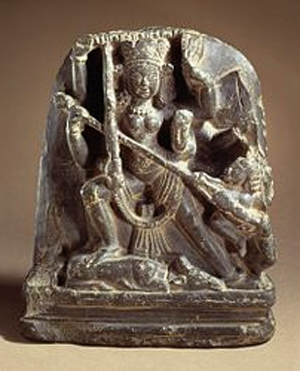 9th-century Kashmir,
9th-century Kashmir, 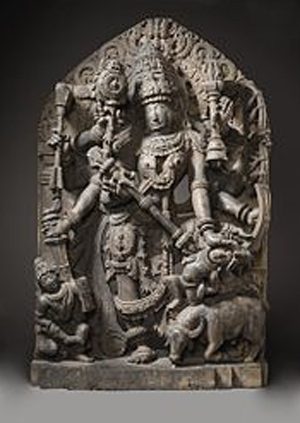 13th-century Karnataka,
13th-century Karnataka, 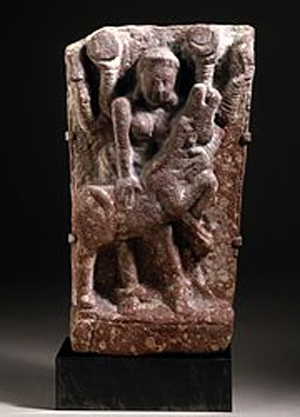 9th century Prambanan Indonesia,
9th century Prambanan Indonesia, 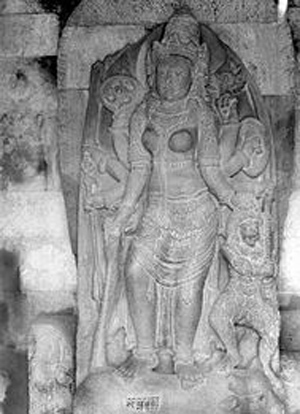 2nd-century Uttar Pradesh.
2nd-century Uttar Pradesh.Devi's epithets synonymous with Durga appear in Upanishadic literature, such as Kali in verse 1.2.4 of the Mundaka Upanishad dated to about the 5th century BCE.[40] This single mention describes Kali as "terrible yet swift as thought", very red and smoky coloured manifestation of the divine with a fire-like flickering tongue, before the text begins presenting its thesis that one must seek self-knowledge and the knowledge of the eternal Brahman.[41]
Durga, in her various forms, appears as an independent deity in the Epics period of ancient India, that is the centuries around the start of the common era.[42] Both Yudhisthira and Arjuna characters of the Mahabharata invoke hymns to Durga.[40] She appears in Harivamsa in the form of Vishnu's eulogy, and in Pradyumna prayer.[42] Various Puranas from the early to late 1st millennium CE dedicate chapters of inconsistent mythologies associated with Durga.[40] Of these, the Markandeya Purana and the Devi-Bhagavata Purana are the most significant texts on Durga.[43][44] The Devi Upanishad and other Shakta Upanishads, mostly dated to have been composed in or after the 9th century, present the philosophical and mystical speculations related to Durga as Devi and other epithets, identifying her to be the same as the Brahman and Atman (self, soul).[45][46]
OriginsThe historian Ramaprasad Chanda stated in 1916 that Durga evolved over time in the Indian subcontinent. A primitive form of Durga, according to Chanda, was the result of "syncretism of a mountain-goddess worshiped by the dwellers of the Himalaya and the Vindhyas", a deity of the Abhiras conceptualised as a war-goddess. Durga then transformed into Kali as the personification of the all-destroying time, while aspects of her emerged as the primordial energy (Adya Sakti) integrated into the samsara (cycle of rebirths) concept and this idea was built on the foundation of the Vedic religion, mythology and philosophy.[47]
Epigraphical evidence indicates that regardless of her origins, Durga is an ancient goddess. The 6th-century CE inscriptions in early Siddhamatrika script, such as at the Nagarjuni hill cave during the Maukhari era, already mention the legend of her victory over Mahishasura (buffalo-hybrid demon).[48]
European traders and colonial era referencesSome early European accounts refer to a deity known as Deumus, Demus or Deumo. Western (Portuguese) sailors first came face to face with the murti of Deumus at Calicut on the Malabar Coast and they concluded it to be the deity of Calicut. Deumus is sometimes interpreted as an aspect of Durga in Hindu mythology and sometimes as deva. It is described that the ruler of Calicut (Zamorin) had a murti of Deumus in his temple inside his royal palace.[49]
Legends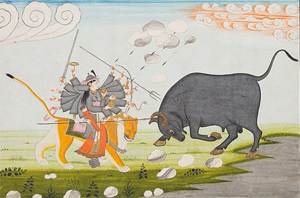 'Durga in Combat with the Bull, Mahishasura', 19th century painting
'Durga in Combat with the Bull, Mahishasura', 19th century paintingThe most popular legend associated with the goddess is of her killing of Mahishasura. Mahishasura was half buffalo demon who did severe penance in order to please Brahma, the creator. After several years, Brahma, pleased with his devotion appeared before the demon. The demon opened his eyes and asked the god for immortality. Brahma refused, stating that all must die one day. Mahishasura then thought for a while and asked a boon that only a woman should be able to kill him. Brahma granted the boon and disappeared. Mahishasura started to torture innocent people. He captured heaven and was not in any kind of fear, as he thought women to be powerless and weak. The devas were worried and they went to Trimurti. They all together combined their power and created a warrior woman with many hands. The devas gave her a copy of their weapons. Himavan, the lord of Himalayas, gifted a lion as her mount. Durga on her lion, reached before Mahishasura's palace. Mahishasura took different forms and attacked the goddess. Each time, Durga would destroy his form. At last, Durga slayed Mahishasura when he was transforming as a buffalo.[50][51]
Attributes and iconography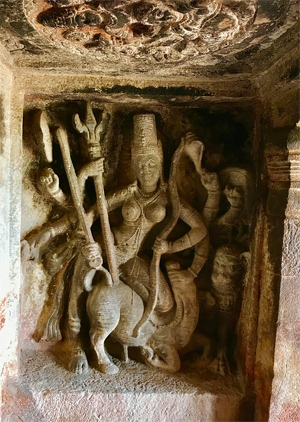 Durga as buffalo-demon slayer from a 6th century Aihole Hindu temple, Karnataka;
Durga as buffalo-demon slayer from a 6th century Aihole Hindu temple, Karnataka;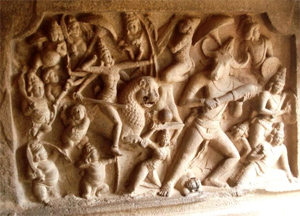 in Mahabalipuram, Tamil Nadu.
in Mahabalipuram, Tamil Nadu.Durga has been a warrior goddess, and she is depicted to express her martial skills. Her iconography typically resonates with these attributes, where she rides a lion or a tiger,[1] has between eight and eighteen hands, each holding a weapon to destroy and create.[52][53] She is often shown in the midst of her war with Mahishasura, the buffalo demon, at the time she victoriously kills the demonic force. Her icon shows her in action, yet her face is calm and serene.[54][55] In Hindu arts, this tranquil attribute of Durga's face is traditionally derived from the belief that she is protective and violent not because of her hatred, egotism or getting pleasure in violence, but because she acts out of necessity, for the love of the good, for liberation of those who depend on her, and a mark of the beginning of soul's journey to creative freedom.[55][56][57]
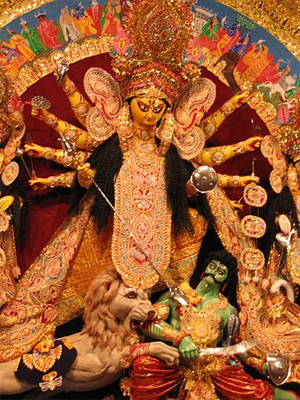 Durga killing Mahishasura in a Durga Puja celebration in Bengal
Durga killing Mahishasura in a Durga Puja celebration in BengalDurga traditionally holds the weapons of various male gods of Hindu mythology, which they give her to fight the evil forces because they feel that she is the shakti (energy, power).[58] These include chakra, conch, bow, arrow, sword, javelin, trishul, shield, and a noose.[59] These weapons are considered symbolic by Shakta Hindus, representing self-discipline, selfless service to others, self-examination, prayer, devotion, remembering her mantras, cheerfulness and meditation. Durga herself is viewed as the "Self" within and the divine mother of all creation.[60] She has been revered by warriors, blessing their new weapons.[61] Durga iconography has been flexible in the Hindu traditions, where for example some intellectuals place a pen or other writing implements in her hand since they consider their stylus as their weapon.[61]
Archeological discoveries suggest that these iconographic features of Durga became common throughout India by about the 4th century CE, states David Kinsley – a professor of religious studies specialising on Hindu goddesses.[62] Durga iconography in some temples appears as part of Mahavidyas or Saptamatrkas (seven mothers considered forms of Durga). Her icons in major Hindu temples such as in Varanasi include relief artworks that show scenes from the Devi Mahatmya.[63]
In Vaishnavism, Durga whose mount is Lion, is considered as one of the three aspects or forms of Goddess Lakshmi, the other two being Sri and Bhu.[64] According to professor Tracy Pintchman, "When the Lord Vishnu created the gunas of prakriti, there arose Lakshmi in her three forms, Sri, Bhu and Durga. Sri consisted of sattva, Bhu as rajas and Durga as tamas".[65]
Durga appears in Hindu mythology in numerous forms and names, but ultimately all these are different aspects and manifestations of one goddess. She is imagined to be terrifying and destructive when she has to be, but benevolent and nurturing when she needs to be.[66] While anthropomorphic icons of her, such as those showing her riding a lion and holding weapons, are common, the Hindu traditions use aniconic forms and geometric designs (yantra) to remember and revere what she symbolises.[67]
Worship and festivalsDurga is worshipped in Hindu temples across India and Nepal by Shakta Hindus. Her temples, worship and festivals are particularly popular in eastern and northeastern parts of Indian subcontinent during Durga puja, Dashain and Navaratri.[2][23][68]
Durga pujaMain article: Durga Puja
Durga festival images
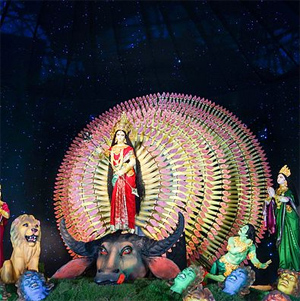 Durga Puja pandal with a Durga idol with 1 million hands standing on top a bull's head to symbolize her victory over Mahishasura in Kolkata,
Durga Puja pandal with a Durga idol with 1 million hands standing on top a bull's head to symbolize her victory over Mahishasura in Kolkata, 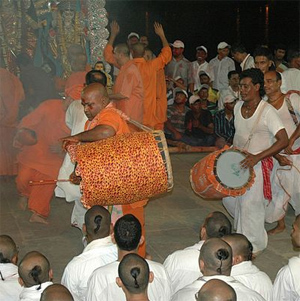 Dancing on Vijaya Dashami,
Dancing on Vijaya Dashami, 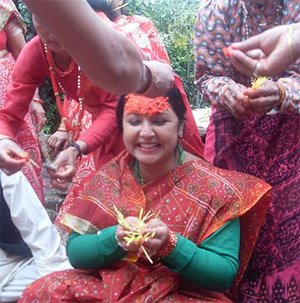 women smearing each other with colour,
women smearing each other with colour, 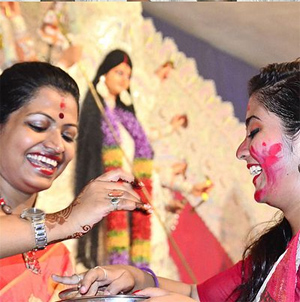 and family get together for Dashain in Nepal.
and family get together for Dashain in Nepal.As per the Markandeya Purana, Durga Puja can be performed either for 9 days or 4 days (last four in sequence). The four-day-long Durga Puja is a major annual festival in Bengal, Odisha, Assam, Jharkhand and Bihar.[2][23] It is scheduled per the Hindu luni-solar calendar in the month of Ashvina,[69] and typically falls in September or October. Since it is celebrated during Sharad (literally, season of weeds), it is called as Sharadiya Durga Puja or Akal-Bodhan to differentiate it from the one celebrated originally in spring. The festival is celebrated by communities by making special colourful images of Durga out of clay,[70] recitations of Devi Mahatmya text,[69] prayers and revelry for nine days, after which it is taken out in procession with singing and dancing, then immersed in water. The Durga puja is an occasion of major private and public festivities in the eastern and northeastern states of India.[2][71][72]
The day of Durga's victory is celebrated as Vijayadashami (Bijoya in Bengali), Dashain (Nepali) or Dussehra (in Hindi) – these words literally mean "the victory on the Tenth (day)".[73]
This festival is an old tradition of Hinduism, though it is unclear how and in which century the festival began. Surviving manuscripts from the 14th century provide guidelines for Durga puja, while historical records suggest royalty and wealthy families were sponsoring major Durga puja public festivities since at least the 16th century.[71] The 11th or 12th century Jainism text Yasatilaka by Somadeva mentions a festival and annual dates dedicated to a warrior goddess, celebrated by the king and his armed forces, and the description mirrors attributes of a Durga puja.[69]
The prominence of Durga puja increased during the British Raj in Bengal.[74] After the Hindu reformists identified Durga with India, she became an icon for the Indian independence movement.[citation needed]The city of Kolkata is famous for Durga puja.
DashainIn Nepal, the festival dedicated to Durga is called Dashain (sometimes spelled as Dasain), which literally means "the ten".[68] Dashain is the longest national holiday of Nepal, and is a public holiday in Sikkim and Bhutan. During Dashain, Durga is worshipped in ten forms (Shailaputri, Brahmacharini, Chandraghanta, Kushmanda, Skandamata, Katyayani, Kalaratri, Mahagauri, Mahakali and Durga) with one form for each day in Nepal. The festival includes animal sacrifice in some communities, as well as the purchase of new clothes and gift giving. Traditionally, the festival is celebrated over 15 days, the first nine-day are spent by the faithful by remembering Durga and her ideas, the tenth day marks Durga's victory over Mahisura, and the last five days celebrate the victory of good over evil.[68]
During the first nine days, nine aspects of Durga known as Navadurga are meditated upon, one by one during the nine-day festival by devout Shakti worshippers. Durga Puja also includes the worship of Shiva, who is Durga's consort, in addition to Lakshmi, Saraswati, Ganesha and Kartikeya, who are considered to be Durga's children.[75] Some Shaktas worship Durga's symbolism and presence as Mother Nature. In South India, especially Andhra Pradesh, Dussera Navaratri is also celebrated and the goddess is dressed each day as a different Devi, all considered equivalent but another aspect of Durga.
Other culturesIn Bangladesh, the four-day-long Sharadiya Durga Puja is the most important religious festival for the Hindus and celebrated across the country with Vijayadashami being a national holiday. In Sri Lanka, Durga in the form of Vaishnavi, bearing Vishnu's iconographic symbolism is celebrated. This tradition has been continued by Sri Lankan diaspora.[76]
In Buddhism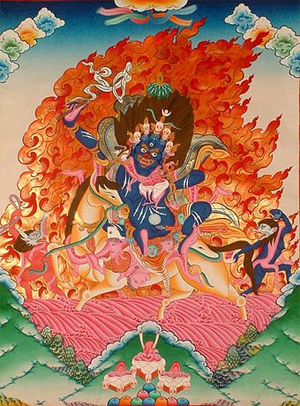 The Buddhist goddess Palden Lhamo shares some attributes of Durga.[77]
The Buddhist goddess Palden Lhamo shares some attributes of Durga.[77]According to scholars, over its history, Buddhist Tantric traditions have adopted several Hindu deities into its fold.[78][79][80] The Tantric traditions of Buddhism included Durga and developed the idea further.[81] In Japanese Buddhism, she appears as Butsu-mo (sometimes called Koti-sri).[82] In Tibet, the goddess Palden Lhamo is similar to the protective and fierce Durga.[83][77] Several aspects of Tārā is believed to have originated as a form of the goddess Durga, notably her fierce guardian form.[84]
In JainismThe Sacciya mata found in major medieval era Jain temples mirrors Durga, and she has been identified by Jainism scholars to be the same or sharing a more ancient common lineage.[85] In the Ellora Caves, the Jain temples feature Durga with her lion mount. However, she is not shown as killing the buffalo demon in the Jain cave, but she is presented as a peaceful deity.[86]
In SikhismSee also: Chandi di Var
Durga is exalted as the divine in Dasam Granth, a sacred text of Sikhism that is traditionally attributed to Guru Gobind Singh.[87] According to Eleanor Nesbitt, this view has been challenged by Sikhs who consider Sikhism to be monotheistic, who hold that a feminine form of the Supreme and a reverence for the Goddess is "unmistakably of Hindu character".[87]
Outside Indian subcontinentGoddess Durga in Southeast Asia
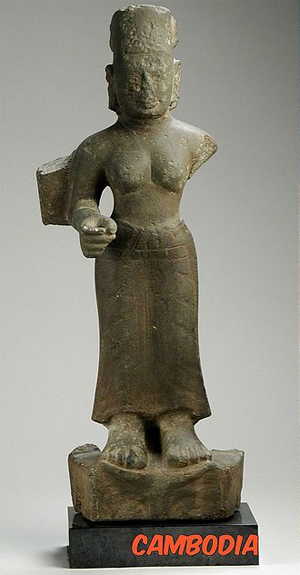 7th/8th century Cambodia,
7th/8th century Cambodia, 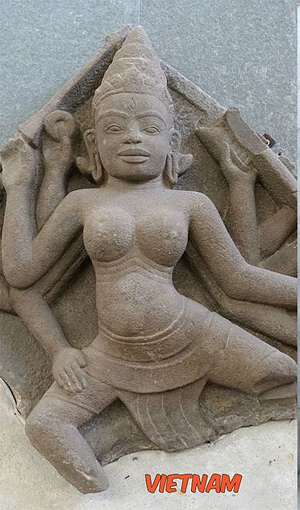 10/11th century Vietnam,
10/11th century Vietnam, 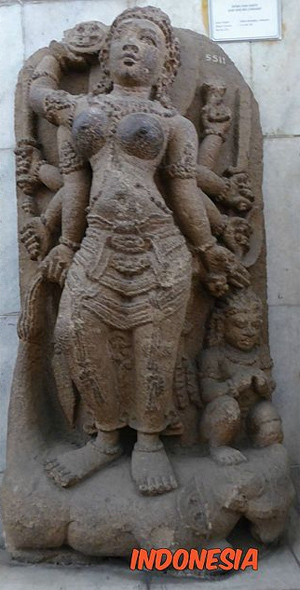 8th/9th century Indonesia.
8th/9th century Indonesia.Archeological site excavations in Indonesia, particularly on the island of Java, have yielded numerous statues of Durga. These have been dated to be from 6th century onwards.[88] Of the numerous early to mid medieval era Hindu deity stone statues uncovered on Indonesian islands, at least 135 statues are of Durga.[89] In parts of Java, she is known as Loro Jonggrang (literally, "slender maiden").[90]
In Cambodia, during its era of Hindu kings, Durga was popular and numerous sculptures of her have been found. However, most differ from the Indian representation in one detail. The Cambodian Durga iconography shows her standing on top of the cut buffalo demon head.[91]
Durga statues have been discovered at stone temples and archaeological sites in Vietnam, likely related to Champa or Cham dynasty era.[92][93]
InfluenceDurga is a major goddess in Hinduism, and the inspiration of Durga Puja – a large annual festival particularly in the eastern and northeastern states of India.[94]
One of the devotees of her form as Kali was Sri Ramakrishna who was the guru of Swami Vivekananda. He is the founder of the Ramakrishna Mission.
Durga as the mother goddess is the inspiration behind the song Vande Mataram, written by Bankim Chandra Chatterjee, during Indian independence movement, later the official national song of India. Durga is present in Indian Nationalism where Bharat Mata i.e. Mother India is viewed as a form of Durga. This is completely secular and keeping in line with the ancient ideology of Durga as Mother and protector to Indians. She is present in pop culture and blockbuster Bollywood movies like Jai Santoshi Maa. The Indian Army uses phrases like "Durga Mata ki Jai!" and "Kaali Mata ki Jai!". Any woman who takes up a cause to fight for goodness and justice is said to have the spirit of Durga in her.[95][96]
Notes1. In Hinduism, encompassing Shaktism, Shaivism, and Vaishnavism, consider her intrinsically identical and interchangeable with Shiva, her spouse.
2. It appears in Khila (appendix, supplementary) text to Rigveda 10.127, 4th Adhyaya, per J. Scheftelowitz.[29]
3. In the Shakta tradition of Hinduism, many of the stories about obstacles and battles have been considered as metaphors for the divine and demonic within each human being, with liberation being the state of self-understanding whereby a virtuous nature and society emerging victorious over the vicious.[34]
References1. Robert S Ellwood & Gregory D Alles 2007, p. 126.
2. Wendy Doniger 1999, p. 306.
3.
1. Raman, Sita Anantha (8 June 2009). Women in India: A Social and Cultural History [2 volumes]: A Social and Cultural History. ABC-CLIO. ISBN 978-0-313-01440-6.
2. Kumar, Vijaya (1 December 1998). 108 Names of Durga. Sterling Publishers Pvt. Ltd. ISBN 978-81-207-2027-5.
3. Original Sanskrit Texts on the Origin and History of the People of India, Their Religion and Institutions: Comparison of the Vedic with the later representations of the principal Indian deities. Trübner. 1863.
4. Parthasarathy, V. R.; Parthasarathy, Indu (2009). Devi: Goddesses in Indian Art and Literature. Bharatiya Kala Prakashan. ISBN 978-81-8090-203-1.
4.
1. Encyclopedia of Hinduism by Constance A. Jones and James D. Ryan
2. The Illustrated Encyclopedia of Hinduism by James G. Lochtefeld,
3. Handbook of Hindu mythology
4. Puranic Encyclopedia by Vettam Mani
5. Encyclopedia of Psychology and Religion by David A. Leeming, Kathryn Madden, Stanton Marlan (Eds.)
6. South Indian Sculptures: A Reappraisal by Pratapaditya Pal (Boston Museum Bulletin, Vol. 67, No. 350 (1969))
7. Hindu Goddesses : Visions of the Divine Feminine in the Hindu Religious Tradition by David Kinsley
5.
https://books.google.co.in/books?id=LVp ... AHoECAUQAw6. Encyclopedia Britannica 2015.
7. David R Kinsley 1989, pp. 3–4.
8. Charles Phillips, Michael Kerrigan & David Gould 2011, pp. 93–94.
9. Paul Reid-Bowen 2012, pp. 212–213.
10. Laura Amazzone 2012, pp. 3–5.
11. David R Kinsley 1989, pp. 3–5.
12. Laura Amazzone 2011, pp. 71–73.
13. Donald J LaRocca 1996, pp. 5–6.
14. Lynn Foulston & Stuart Abbott 2009, pp. 9–17.
15. June McDaniel 2004, pp. 215–216.
16. David Kinsley 1988, pp. 101–102.
17. Laura Amazzone 2012, p. xi.
18. Cheever Mackenzie Brown 1998, p. 77 note 28.
19. Thomas B. Coburn 1991, pp. 13.
20. Thomas B. Coburn 2002, p. 1.
21. Ludo Rocher 1986, p. 193.
22. Hillary Rodrigues 2003, pp. 50–54.
23. James G Lochtefeld 2002, p. 208.
24. Constance Jones & James D Ryan 2006, pp. 139–140, 308–309.
25. Laura Amazzone 2012, p. xxii.
26. Monier Monier Williams (1899), Sanskrit English Dictionary with Etymology, Oxford University Press, page 487
27. Alain Daniélou 1991, p. 21.
28. Maurice Bloomfield (1906), A Vedic concordance, Series editor: Charles Lanman, Harvard University Press, page 486;
Example Sanskrit original: "अहन्निन्द्रो अदहदग्निरिन्दो पुरा दस्यून्मध्यंदिनादभीके । दुर्गे दुरोणे क्रत्वा न यातां पुरू सहस्रा शर्वा नि बर्हीत् ॥३॥ – Rigveda 4.28.8, Wikisource
29. J Scheftelowitz (1906). Indische Forschungen. Verlag von M & H Marcus. pp. 112 line 13a.
30. David Kinsley 1988, pp. 95–96.
31. Thomas B. Coburn 2002, pp. 1–7.
32. Alain Daniélou 1991, p. 288.
33. June McDaniel 2004, pp. 215–219.
34. June McDaniel 2004, pp. 20–21, 217–219.
35. Hiltebeitel, Alf (1988). The Cult of Draupadi, Volume 2: On Hindu Ritual and the Goddess. University of Chicago Press. p. 386. ISBN 978-0-226-34048-7.
36. Thapar, Valmik (1 January 1997). Land of the Tiger: A Natural History of the Indian Subcontinent. University of California Press. p. 15. ISBN 978-0-520-21470-5.
37. June McDaniel 2004, p. 90.
38. Cheever Mackenzie Brown 1998, p. 26.
39. The Rig Veda/Mandala 10/Hymn 125 Ralph T.H. Griffith (Translator); for Sanskrit original see: ऋग्वेद: सूक्तं १०.१२५
40. Rachel Fell McDermott 2001, pp. 162–163.
41. Mundaka Upanishad, Robert Hume, The Thirteen Principal Upanishads, Oxford University Press, pages 368–377 with verse 1.2.4
42. Rachel Fell McDermott 2001, p. 162.
43. Ludo Rocher 1986, pp. 168–172, 191–193.
44. C Mackenzie Brown 1990, pp. 44–45, 129, 247–248 with notes 57–60.
45. Douglas Renfrew Brooks 1992, pp. 76–80.
46. June McDaniel 2004, pp. 89–91.
47. June McDaniel 2004, p. 214.
48. Richard Salomon (1998). Indian Epigraphy: A Guide to the Study of Inscriptions in Sanskrit, Prakrit, and the Other Indo-Aryan Languages. Oxford University Press. pp. 200–201. ISBN 978-0-19-509984-3.
49. Jörg Breu d. Ä. zugeschrieben, Idol von Calicut, in: Ludovico de Varthema, 'Die Ritterlich und lobwürdig Reisz', Strassburg 1516. (Bild: Völkerkundemuseum der Universität Zürich
50. Roa, Subba (April 1971). Tales of Durga. Amar Chitra Katha Private Limited. p. 25. ISBN 81-89999-35-4.
51. Kumar, Anu (30 November 2012). Mahishasura: The Buffalo Demon. Hachette India. ISBN 978-93-5009-538-6.
52. Laura Amazzone 2012, pp. 4–5.
53. Chitrita Banerji 2006, pp. 3–5.
54. Donald J LaRocca 1996, pp. 5–7.
55. Linda Johnsen (2002). The Living Goddess: Reclaiming the Tradition of the Mother of the Universe. Yes International Publishers. pp. 83–84. ISBN 978-0-936663-28-9.
56. Laura Amazzone 2012, pp. 4–9, 14–17.
57. Malcolm McLean 1998, pp. 60–65.
58. Alf Hiltebeitel; Kathleen M. Erndl (2000). Is the Goddess a Feminist?: The Politics of South Asian Goddesses. New York University Press. pp. 157–158. ISBN 978-0-8147-3619-7.
59. Charles Russell Coulter & Patricia Turner 2013, p. 158.
60. Linda Johnsen (2002). The Living Goddess: Reclaiming the Tradition of the Mother of the Universe. Yes International Publishers. pp. 89–90. ISBN 978-0-936663-28-9.
61. Alf Hiltebeitel; Kathleen M. Erndl (2000). Is the Goddess a Feminist?: The Politics of South Asian Goddesses. New York University Press. pp. 15–16. ISBN 978-0-8147-3619-7.
62. David Kinsley 1988, pp. 95–105.
63. David Kinsley 1997, pp. 30–35, 60, 16–22, 149.
64. Isaeva 1993, p. 252.
65. Pintchman 2014, p. 82.
66. Patricia Monaghan 2011, pp. 73–74.
67. Patricia Monaghan 2011, pp. 73–78.
68. J Gordon Melton (2011). Religious Celebrations: An Encyclopedia of Holidays, Festivals, Solemn Observances, and Spiritual Commemorations. ABC-CLIO. pp. 239–241. ISBN 978-1-59884-206-7.
69. David Kinsley 1988, pp. 106–108.
70. David Kinsley 1997, pp. 18–19.
71. Rachel Fell McDermott 2001, pp. 172–174.
72. Lynn Foulston & Stuart Abbott 2009, pp. 162–169.
73. Esposito, John L.; Darrell J Fasching; Todd Vernon Lewis (2007). Religion & globalization: world religions in historical perspective. Oxford University Press. p. 341. ISBN 978-0-19-517695-7.
74. "Article on Durga Puja". Archived from the original on 28 December 2015. Retrieved 11 October 2013.
75. Kinsley, David (1988) Hindu Goddesses: Vision of the Divine Feminine in the Hindu Religious Traditions. University of California Press. ISBN 0-520-06339-2 p. 95
76. Joanne Punzo Waghorne (2004). Diaspora of the Gods: Modern Hindu Temples in an Urban Middle-Class World. Oxford University Press. pp. 222–224. ISBN 978-0-19-803557-2.
77. Miranda Eberle Shaw (2006). Buddhist Goddesses of India. Princeton University Press. pp. 240–241. ISBN 0-691-12758-1.
78. Wayman, Alex; The Buddhist Tantras light on Indo-Tibetan esotericism, Routledge, (2008), page 23.
79. Williams, Tribe and Wynne; Buddhist Thought: A Complete Introduction to the Indian Tradition, chapter 7
80. Hajime Nakamura (1980). Indian Buddhism: A Survey with Bibliographical Notes. Motilal Banarsidass. p. 315. ISBN 978-81-208-0272-8.
81. Shoko Watanabe (1955), On Durga and Tantric Buddhism, Chizan Gakuho, number 18, pages 36-44
82. Louis-Frédéric (1995). Buddhism. Flammarion. p. 174. ISBN 978-2-08-013558-2.
83. Bernard Faure (2009). The Power of Denial: Buddhism, Purity, and Gender. Princeton University Press. p. 127. ISBN 978-1400825615.
84. Mallar Ghosh (1980). Development of Buddhist Iconography in Eastern India. Munshiram Manoharlal. p. 17. ISBN 81-215-0208-X.
85. Lawrence A. Babb (1998). Ascetics and kings in a Jain ritual culture. Motilal Banarsidass. pp. 146–147, 157. ISBN 978-81-208-1538-4.
86. Lisa Owen (2012). Carving Devotion in the Jain Caves at Ellora. BRILL Academic. pp. 111–112. ISBN 978-90-04-20630-4.
87. Eleanor Nesbitt (2016). Sikhism: A Very Short Introduction. Oxford University Press. pp. 108–109. ISBN 978-0-19-106277-3.
88. John N. Miksic (2007). Icons of Art: The Collections of the National Museum of Indonesia. BAB Pub. Indonesia. pp. 106, 224–238. ISBN 978-979-8926-25-9.
89. Ann R Kinney; Marijke J Klokke; Lydia Kieven (2003). Worshiping Siva and Buddha: The Temple Art of East Java. University of Hawaii Press. pp. 131–145. ISBN 978-0-8248-2779-3.
90. Roy E Jordaan; Koninklijk Instituut voor Taal-, Land- en Volkenkunde (Netherlands) (1996). In praise of Prambanan: Dutch essays on the Loro Jonggrang temple complex. KITLV Press. pp. 147–149. ISBN 978-90-6718-105-1.
91. Trudy Jacobsen (2008). Lost Goddesses: The Denial of Female Power in Cambodian History. Copenhagen: Nordic Institute of Asian Studies Press. pp. 20–21 with figure 2.2. ISBN 978-87-7694-001-0.
92. Heidi Tan (2008). Vietnam: from myth to modernity. Singapore: Asian Civilisations Museum. pp. 56, 62–63. ISBN 978-981-07-0012-6.
93. Catherine Noppe; Jean-François Hubert (2003). Art of Vietnam. Parkstone. p. 104. ISBN 978-1-85995-860-5.
94. "Durga Puja – Hindu festival". Encyclopedia Britannica. 2015.
95. Sabyasachi Bhattacharya (2003). Vande Mataram, the Biography of a Song. Penguin. pp. 5, 90–99. ISBN 978-0-14-303055-3.
96. Sumathi Ramaswamy (2009). The Goddess and the Nation: Mapping Mother India. Duke University Press. pp. 106–108. ISBN 978-0-8223-9153-1.
Bibliography• Laura Amazzone (2012). Goddess Durga and Sacred Female Power. University Press of America. ISBN 978-0-7618-5314-5.
• Laura Amazzone (2011). Patricia Monaghan (ed.). Goddesses in World Culture. ABC-CLIO. ISBN 978-0-313-35465-6.
• Chitrita Banerji (2006). The Hour of the Goddess: Memories of Women, Food, and Ritual in Bengal. Penguin Books India. ISBN 978-0-14-400142-2.
• Douglas Renfrew Brooks (1992). Auspicious Wisdom. State University of New York Press. ISBN 978-0-7914-1145-2.
• C Mackenzie Brown (1990). The Triumph of the Goddess: The Canonical Models and Theological Visions of the Devi-Bhagavata Purana. State University of New York Press. ISBN 978-0-7914-0364-8.
• Cheever Mackenzie Brown (1998). The Devi Gita: The Song of the Goddess: A Translation, Annotation, and Commentary. State University of New York Press. ISBN 978-0-7914-3939-5.
• Thomas B. Coburn (1991). Encountering the Goddess: A translation of the Devi-Mahatmya and a Study of Its Interpretation. State University of New York Press. ISBN 978-0-7914-0446-1.
• Thomas B. Coburn (2002). Devī Māhātmya, The Crystallization of the Goddess Tradition. South Asia Books. ISBN 81-208-0557-7.
• Charles Russell Coulter; Patricia Turner (2013). Encyclopedia of Ancient Deities. Routledge. ISBN 978-1-135-96397-2.
• Paul Reid-Bowen (2012). Denise Cush; Catherine Robinson; Michael York (eds.). Encyclopedia of Hinduism. Routledge. ISBN 978-1-135-18979-2.
• Alain Daniélou (1991). The Myths and Gods of India: The Classic Work on Hindu Polytheism from the Princeton Bollingen Series. Inner Traditions / Bear & Co. ISBN 978-0-89281-354-4.
• Wendy Doniger (1999). Merriam-Webster's Encyclopedia of World Religions. Merriam-Webster. ISBN 978-0-87779-044-0.
• Robert S Ellwood; Gregory D Alles (2007). The Encyclopedia of World Religions. Infobase Publishing. ISBN 978-1-4381-1038-7.
• Lynn Foulston; Stuart Abbott (2009). Hindu Goddesses: Beliefs and Practices. Sussex Academic Press. ISBN 978-1-902210-43-8.
• Constance Jones; James D Ryan (2006). Encyclopedia of Hinduism. Infobase Publishing. ISBN 978-0-8160-7564-5.
• David R Kinsley (1989). The Goddesses' Mirror: Visions of the Divine from East and West. State University of New York Press. ISBN 978-0-88706-835-5.
• David Kinsley (1988). Hindu Goddesses: Visions of the Divine Feminine in the Hindu Religious Tradition. University of California Press. ISBN 978-0-520-90883-3.
• David Kinsley (1997). Tantric Visions of the Divine Feminine: The Ten Mahavidyas. University of California Press. ISBN 978-0-520-91772-9.
• Donald J LaRocca (1996). The Gods of War: Sacred Imagery and the Decoration of Arms and Armor. Metropolitan Museum of Art. ISBN 978-0-87099-779-2.
• James G Lochtefeld (2002). The Illustrated Encyclopedia of Hinduism: A-M. The Rosen Publishing Group. ISBN 978-0-8239-3179-8.
• June McDaniel (2004). Offering Flowers, Feeding Skulls: Popular Goddess Worship in West Bengal. Oxford University Press. ISBN 978-0-19-534713-5.
• Rachel Fell McDermott (2001). Mother of My Heart, Daughter of My Dreams: Kali and Uma in the Devotional Poetry of Bengal. Oxford University Press. ISBN 978-0-19-803071-3.
• Malcolm McLean (1998). Devoted to the Goddess: The Life and Work of Ramprasad. State University of New York Press. ISBN 978-0-7914-3689-9.
• Patricia Monaghan (2011). Goddesses in World Culture. ABC-CLIO. ISBN 978-0-313-35465-6.
• Sree Padma (2014). Inventing and Reinventing the Goddess: Contemporary Iterations of Hindu Deities on the Move. Lexington Books. ISBN 978-0-7391-9002-9.
• Charles Phillips; Michael Kerrigan; David Gould (2011). Ancient India's Myths and Beliefs. The Rosen Publishing Group. ISBN 978-1-4488-5990-0.
• Ludo Rocher (1986). The Puranas. Otto Harrassowitz Verlag. ISBN 978-3447025225.
• Sen Ramprasad (1720–1781). Grace and Mercy in Her Wild Hair: Selected Poems to the Mother Goddess. Hohm Press. ISBN 0-934252-94-7.
• Hillary Rodrigues (2003). Ritual Worship of the Great Goddess: The Liturgy of the Durga Puja with Interpretations. SUNY Press. ISBN 978-0-7914-8844-7.
• "Durga - Hindu mythology". Encyclopedia Britannica. 19 February 2015. Retrieved 15 February 2017.
• Isaeva, N. V. (1993), Shankara and Indian Philosophy, SUNY Press, ISBN 978-0791412817
• Pintchman, Tracy (2014), Seeking Mahadevi: Constructing the Identities of the Hindu Great Goddess, SUNY Press, ISBN 978-0791490495
• Chiulli, M. C. Kalavati (2007), Hairakhandi Mantra & Bhajans, J. Amba Edizioni publishing house, ISBN 978-8886340465
External links• Hinduism portal
• India portal
• Religion portal
Durgaat Wikipedia's sister projects
• Media from Wikimedia Commons
• Quotations from Wikiquote
• Durga at the Encyclopædia Britannica
• Durga Battling the Buffalo Demon: Iconography, Carlos Museum, Emory University
• Devi Durga, Arthur M. Sackler Gallery and Freer Gallery of Art, Smithsonian Institution
• Overview Of World Religions – Devotion to Durga
